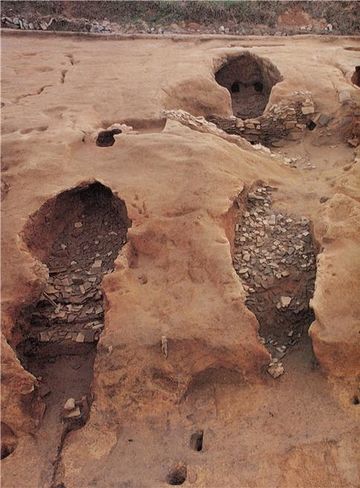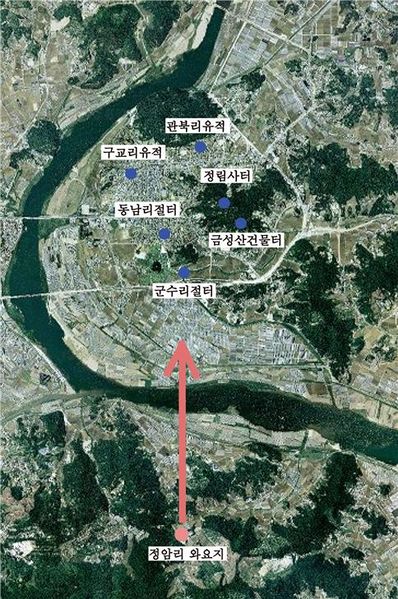부여 정암리 와요지
| 부여 정암리 와요지 Roof Tile Kiln Site in Jeongam-ri, Buyeo |
|
| 대표명칭 | 부여 정암리 와요지 |
|---|---|
| 영문명칭 | Roof Tile Kiln Site in Jeongam-ri, Buyeo |
| 한자 | 扶餘 亭岩里 瓦窯址 |
| 주소 | 충청남도 부여군 장암면 정암리 47 |
| 지정(등록) 종목 | 사적 제373호 |
| 지정(등록)일 | 1992년 5월 4일 |
| 분류 | 유적건조물/산업생산/요업/도자기가마 |
| 수량/면적 | 78,793㎡ |
| 웹사이트 | "부여 정암리 와요지", 국가문화유산포털, 문화재청. |
|
|
|
해설문
국문
정암리 와요지*는 부여읍의 남쪽을 흐르는 백마강가 야산의 북쪽 비탈에 있는 백제 사비시기 기와가마터 유적이다.
1988∼1991년 세 차례에 걸쳐 발굴조사가 이루어져, 10기의 백제시대 가마터와 작업장이 확인되었다. 가마터 안에서는 기와와 토기 조각들이 나왔다.
이 가마터 유적에서 생산된 기와는 백마강 건너 사비도성 안의 군수리나 동남리의 절, 관북리유적의 왕궁 관련시설 등에 공급했던 것으로 보인다. 이로 보았을 때, 정암리 와요지는 나라에서 주도하여 기와와 토기를 생산했던 가마터 유적으로 여겨진다.
- 와요지(瓦窯址) : 기와를 만들어 굽던 가마터
국문 2019 11월
부여 정암리 와요지는 백제의 마지막 도읍지였던 사비泗沘현재의 부여 시가지 남쪽 금강백마강가에 자리잡은 백제시대 가마터이다.
이곳은 1987년 여름, 큰 홍수로 흙이 흘러내리면서 발견되었다. 국립부여박물관이 조사한 결과, 백제 가마 11기와 고려 가마 1기, 작업장 관련 시설이 확인되었다.
정암리 가마터는 땔감을 쉽게 구할 수 있는 야산으로 둘러쌓여 있을 뿐만 아니라 금강이 가까이 있어 제품을 운반하기 편해 가마터로서 좋은 환경을 갖추고 있다.
백제 후기인 6세기 후반에서부터 7세기 초반까지 이곳에서 활발하게 기와를 만들었던 것으로 보인다.
부여읍의 관북리 유적과 군수리 절터 등 백제시대 건물 터에서 발견되는 기와는 정암리 가마에서 만든 것과 동일하다. 이곳에서 만들어진 기와와 토기 등이 도성 곳곳에서 사용되었음을 알 수 있다.
정암리 가마터에는 평요平窯*와 등요登窯**가 함께 발견되는데, 정암리 가마와 동일한 구조의 가마가 중국과 일본에서도 확인되고 있어 고대 동북아시아의 문화교류가 활발하게 이루어졌음을 알 수 있다.
정암리 가마터는 큰 규모의 가마터가 단지를 이루고 있어 가마의 변화 과정과 기와 제작 기술을 살펴볼 수 있는 귀중한 유적이다.
- 땅의 경사가 없는 평가마와 경사면의 오름가마로 구분
- 경사지에 터널형으로 만들어진 오름가마
영문
This is a site of kilns used for the production of roof tiles. A total of 12 kilns have been found in this site: 10 kilns dating back to the 6th and 7th centuries, when the Baekje kingdom (18 BCE-660 CE) had its capital in the Buyeo area, one kiln from the Goryeo (918-1392) period, and one kiln from the Joseon (1392-1910) period.
The Jeongam-ri area is well-suited for operating kilns, because of the nearby forested mountains, which are a source of firewood, and the Geumgang River, which was used to transport the products by boat to the capital. The roof-end tiles with lotus design and bricks excavated from this site are similar to those discovered in the temple sites in Gunsu-ri and Dongnam-ri. This suggests that the roof tiles produced in this kiln site were used to build temples and palaces in the capital of the kingdom.
Different types of kilns were discovered in this site, including underground kilns and tunnel kilns. These kilns provide important information about changes in kiln structure and roof tile production techniques.
2019년 영문
This is a site of kilns used for the production of roof tiles. A total of 12 kilns have been found at this site: 11 dating back to the 6th and 7th centuries, when the Buyeo area was the capital of the Baekje kingdom (18 BCE-660 CE), and one from the Goryeo period (918-1392).
The Jeongam-ri area is well-suited for operating kilns, because of the nearby forested mountains, which are a source of firewood, and the nearby Geumgang River, which was used to transport the products by boat to the Baekje capital. The roof tiles produced in this kiln site were used to build temples and palaces in the capital of the kingdom.
Different types of kilns were discovered at this site, including underground kilns and tunnel kilns. These kilns provide important information about changes in kiln structure and roof tile production techniques. Similar kilns were found in China and Japan, showing that there was technological exchange in East Asia around the 6th and 7th centuries.
영문 해설 내용
기와를 굽던 가마터이다. 백제가 부여 지역에 도읍을 두었던 6-7세기의 가마 10기와 고려시대의 가마 1기, 조선시대의 가마 1기 등 총 12개의 가마가 발견되었다.
정암리 일대는 야산에 땔감이 풍부하고, 생산된 기와를 인근 금강을 이용해 도성으로 운반할 수 있어서 가마터로서 좋은 조건을 갖추었다. 이곳에서 출토된 연꽃무늬 수막새와 전돌 등이 군수리나 동남리의 절터에서 출토된 유물과 유사한 것으로 보아, 생산된 기와를 백마강 건너 도성의 절과 왕궁 등에 공급한 것으로 여겨진다.
또한 지하식 가마와 터널식 가마 등 구조가 다른 가마들이 함께 확인되어, 가마의 변화 모습과 기와 제작기술에 대해서 중요한 정보를 제공한다.

